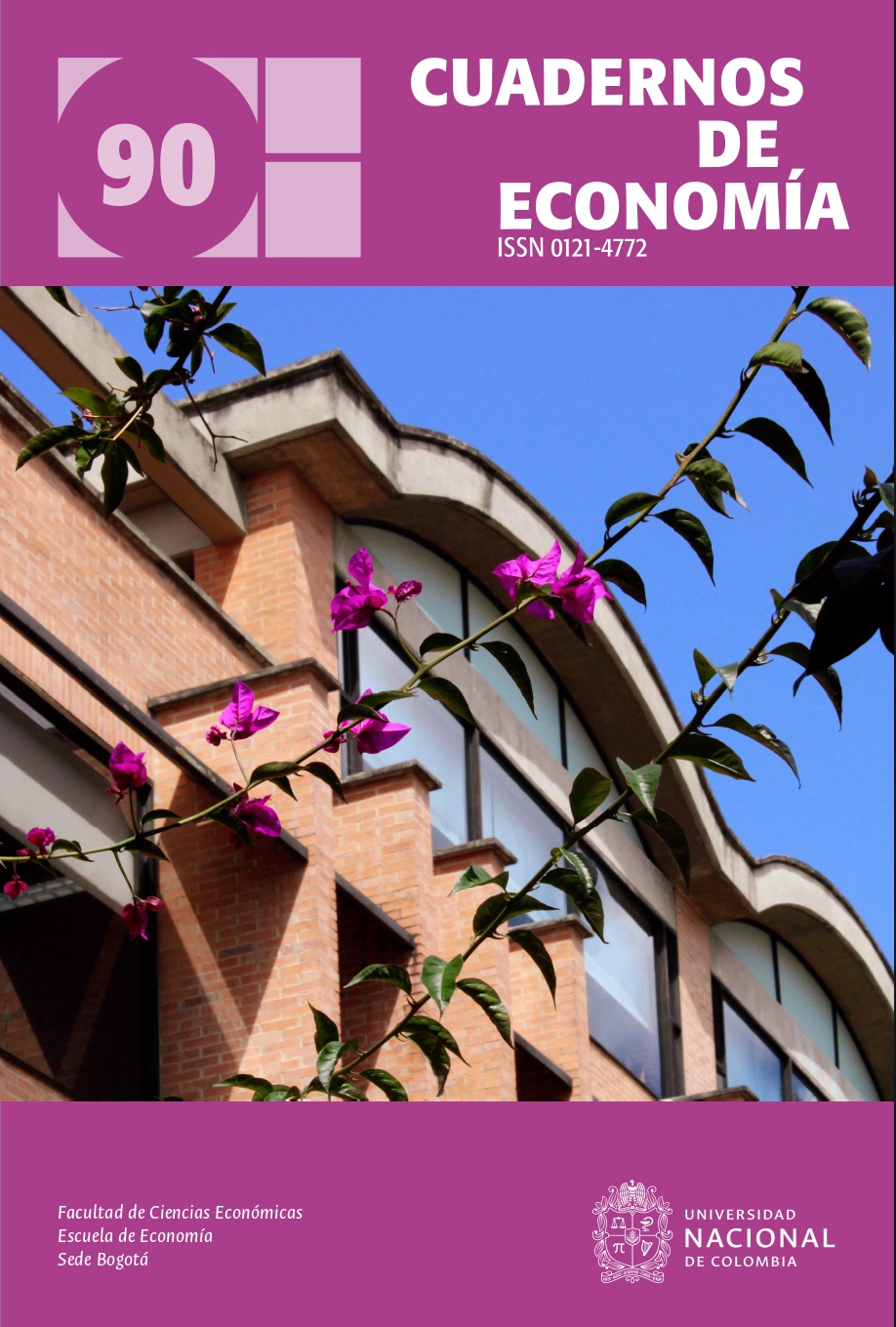Growth and the real exchange rate: the role of technology
Crecimiento y tipo de cambio real: el rol de la tecnología
DOI:
https://doi.org/10.15446/cuad.econ.v42n90.98167Palabras clave:
development macroeconomics, growth, technological capabilities, undervaluation (en)macroeconomía del desarrollo, crecimiento, capacidades tecnológicas, subvaluación cambiaria (es)
Descargas
The aim of this paper is to assess the stability of the impacts of real exchange rate undervaluation and domestic technological capabilities on growth across development levels. Panel regressions with development-level interactions are used to test the stability of these variables’ impact on growth. The results show that real undervaluation is a driver of growth across all development levels, once technological capabilities are accounted for; however, it is more important for developing and developed countries than for emerging countries.
Este artículo evalúa si los impactos de la subvaluación del tipo de cambio real y las capacidades tecnológicas nacionales sobre el crecimiento son estables en todos los niveles de desarrollo. Se utilizan regresiones de panel con interacciones a nivel de desarrollo para probar la estabilidad del impacto en el crecimiento de estas variables. Los resultados muestran que la subvaloración real es un motor de crecimiento en todos los niveles de desarrollo, una vez que se tienen en cuenta las capacidades tecnológicas; sin embargo, la subvaluación es más importante para los países desarrollados y en desarrollo que para los países emergentes.
Referencias
Agénor, P. (1991). Output, devaluation and the real exchange rate in developing countries. Weltwirtschaftliches Archiv, 127(1), 18-41. https://doi.org/10.1007/BF02707309
Alcorta, L., & Peres, W. (1998). Innovation systems and technological specialization in Latin America and the Caribbean. Research Policy, 26(7-8), 857-881. https://doi.org/10.1016/S0048-7333(97)00067-X
Amsden, A. H. (1989). Asia’s next giant: South Korea and late industrialization. Oxford University Press.
Amsden, A. H. (2001). The rise of “the Rest”: Challenges to the West from late-industrializing economies. Oxford University Press. DOI: https://doi.org/10.1093/0195139690.003.0001
Balassa, B. (1964). The purchasing-power parity doctrine: A reappraisal. Journal of Political Economy, 72(6), 584-596. http://www.jstor.org/stable/1829464 DOI: https://doi.org/10.1086/258965
Beck, N., & Katz, J. N. (2011). Modeling dynamics in time-series-cross-section political economy data. Annual Review of Political Science, 14, 331–352. https://doi.org/10.1146/annurev-polisci-071510-103222
Cooper, R. N. (1971). Currency devaluation in developing countries. Essays in International Finance, 86, 3-31.
de Medeiros, C. A. (2020). A structuralist and institutionalist developmental assessment of and reaction to new developmentalism. Review of Keynesian Economics, 8(2), 147-167. https://doi.org/10.4337/roke.2020.02.01
Demir, F., & Razmi, A. (2022). The real exchange rate and development theory, evidence, issues and challenges. Journal of Economic Surveys, 36(2), 386-428. https://doi.org/10.1111/joes.12418
Di John, J. (2011). Is there really a resource curse? A critical survey of theory and evidence. Global Governance, 17(2), 167-184. https://www.jstor.org/stable/23033728 DOI: https://doi.org/10.1163/19426720-01702005
Díaz Alejandro, C. F. (1965). Exchange-rate devaluation in a semi-industrialized country. The experience of Argentina 1955-1961. The MIT Press.
Dornbusch, R. (1985). Purchasing power parity (National Bureau of Economic Research Working Paper Series 1591). https://doi.org/10.3386/w1591
Economic Commission for Latin America and the Caribbean (ECLAC). (2011). Una herramienta para calcular el índice de especialización tecnológica (IET) de las exportaciones de un país a diferentes mercados [Data set].
Fagerberg, J., Lundvall, B.-Å., & Srholec, M. (2018). Global value chains, national innovation systems and economic development. The European Journal of Development Research, 30(3), 533-556. https://doi.org/10.1057/s41287-018-0147-2
Fagerberg, J., & Srholec, M. (2017). Capabilities, economic development, sustainability. Cambridge Journal of Economics, 41(3), 905-926. https://doi.org/10.1093/cje/bew061
Fox, J., & Monette, G. (1992). Generalized collinearity diagnostics. Journal of the American Statistical Association, 87(417), 178-183. DOI: https://doi.org/10.1080/01621459.1992.10475190
Frynas, J. G. (2004). The oil boom in Equatorial Guinea. African Affairs, 103(413), 527-546. https://doi.org/10.1093/afraf/adh085
Glüzmann, P. A., Levy-Yeyati, E., & Sturzenegger, F. (2012). Exchange rate undervaluation and economic growth: Díaz Alejandro (1965) revisited. Economics Letters, 117(3), 666-672. https://doi.org/10.1016/j.econlet.2012.07.022
Hausmann, R., Hwang, J., & Rodrik, D. (2007). What you export matters. Journal of Economic Growth, 12(1), 1-25. https://doi.org/10.1007/s10887-006-9009-4
Hausmann, R., & Rodrik, D. (2003). Economic development as self-discovery. Journal of Development Economics, 72(2), 603-633. https://doi.org/10.1016/S0304-3878(03)00124-X
Heston, A., Summers, R., & Aten, B. (2011). Penn World Table Version 7.0. http://pwt.econ.upenn.edu/php_site/pwt_index.php
Hidalgo, C. A., & Hausmann, R. (2009). The building blocks of economic complexity. Proceedings of the National Academy of Sciences, 106(26), 10570-10575. https://doi.org/10.1073/pnas.0900943106
Honaker, J., & King, G. (2010). What to do about missing values in time-series cross-section data. American Journal of Political Science, 54(2), 561-581. https://doi.org/10.1111/j.1540-5907.2010.00447.x
Hummels, D., Ishii, J., & Yi, K.-M. (2001). The nature and growth of vertical specialization in world trade. Journal of International Economics, 54(1), 75-96. https://doi.org/10.1016/S0022-1996(00)00093-3
Khan, M. S. (2022a). Absorptive capacities and economic growth in low-and middle-income economies. Structural Change and Economic Dynamics, 62, 156-188. https://doi.org/10.1016/j.strueco.2022.03.015
Khan, M. S. (2022b). Absorptive capacities approaches for investigating National Innovation Systems in low and middle income countries. International Journal of Innovation Studies, 6(3), 183-195. https://doi.org/10.1016/j.ijis.2022.07.004
Lenzen, M., Kanemoto, K., Moran, D., & Geschke, A. (2012). Mapping the structure of the world economy. Environmental Science & Technology, 46(15), 8374-8381. https://doi.org/10.1021/es300171x
Lenzen, M., Moran, D., Kanemoto, K., & Geschke, A. (2013). Building Eora: A global multi-region input–output database at high country and sector resolution. Economic Systems Research, 25(1), 20-49. https://doi.org/10.1080/09535314.2013.769938
Levy-Yeyati, E., & Sturzenegger, F. (2007). Fear of appreciation (The World Bank Policy Research Working Paper Series 4387). http://ssrn.com/abstract=1029502 DOI: https://doi.org/10.1596/1813-9450-4387
Lin, J. Y. (2012). New structural economics. A framework for rethinking development and policy. World Bank. DOI: https://doi.org/10.1596/978-0-8213-8955-3
Lucas, R. E., Jr. (1988). On the mechanics of economic development. Journal of Monetary Economics, 22(1), 3-42. https://doi.org/10.1016/0304-3932(88)90168-7
Nelson, R. R. (2008). Economic development from the perspective of evolutionary economic theory. Oxford Development Studies, 36(1), 9-21. https://doi.org/10.1080/13600810701848037
O’Brien, R. M. (2007). A caution regarding rules of thumb for variance inflation factors. Quality & Quantity, 41, 673-690. https://doi.org/10.1007/s11135-006-9018-6
Oreiro, J. L. (2020). New developmentalism: Beyond competitive exchange rate. Brazilian Journal of Political Economy, 40(2), 238-242. https://doi.org/10.1590/0101-31572020-3138
Papanikos, G. T. (2015). The real exchange rate of euro and Greek economic growth. The Journal of Economic Asymmetries, 12(2), 100-109. http://dx.doi.org/10.1016/j.jeca.2015.04.002
Paus, E. (2020). Innovation strategies matter: Latin America’s middle-income trap meets China and globalisation. The Journal of Development Studies, 56(4), 657-679. https://doi.org/10.1080/00220388.2019.1595600
Porcile, G., & Lima, G. T. (2010). Real exchange rate and elasticity of labour supply in a balance-of-payments-constrained macrodynamics. Cambridge Journal of Economics, 34(6), 1019-1039. https://doi.org/10.1093/cje/bep065
Rajan, R. G., & Subramanian, A. (2011). Aid, Dutch disease, and manufacturing growth. Journal of Development Economics, 94(1), 106-118. https://doi.org/10.1016/j.jdeveco.2009.12.004
Rapetti, M., Skott, P., & Razmi, A. (2012). The real exchange rate and economic growth: Are developing countries different? International Review of Applied Economics, 26(6), 735-753. https://doi.org/10.1080/02692171.2012.686483
Razin, O., & Collins, S. M. (1999). Real-exchange-rate misalignments and growth. In A. Razin & E. Sadka (Eds.), The economics of globalization. Policy perspectives from public economics (pp. 59-84). Cambridge University Press. DOI: https://doi.org/10.1017/CBO9780511619946.005
Rodrik, D. (2008). The real exchange rate and economic growth. Brookings Papers on Economic Activity, (2), 365-412. https://doi.org/10.1353/eca.0.0020
Romer, P. M. (1987). Crazy explanations for the productivity slowdown. NBER Macroeconomics Annual, 2, 163-202. DOI: https://doi.org/10.1086/ma.2.4623715
Romer, P. M. (1994). The origins of endogenous growth. Journal of Economic Perspectives, 8(1), 3-22. http://www.jstor.org/stable/2138148 DOI: https://doi.org/10.1257/jep.8.1.3
Sachs, J. D., & Warner, A. M. (2001). The curse of natural resources. European Economic Review, 45(4-6), 827-838. https://doi.org/10.1016/S0014-2921(01)00125-8
Samuelson, P. A. (1964). Theoretical notes on trade problems. The Review of Economics and Statistics, 46(2), 145–154. https://doi.org/10.2307/1928178
Schott, P. (2008). The relative sophistication of Chinese exports. Economic Policy, 23(53), 6-49. https://doi.org/10.1111/j.1468-0327.2007.00195.x
The Economist. (2013). Interactive currency-comparison tool: The Big Mac index. Global exchange rates, to go. http://www.economist.com/content/big-mac-index
van der Ploeg, F. (2011). Natural resources: Curse or blessing? Journal of Economic Literature, 49(2), 366-420. https://www.jstor.org/stable/23071620 DOI: https://doi.org/10.1257/jel.49.2.366
World Bank. (2012). A short history [Data set]. http://data.worldbank.org/about/country-classifications/a-short-history
Cómo citar
APA
ACM
ACS
ABNT
Chicago
Harvard
IEEE
MLA
Turabian
Vancouver
Descargar cita
Licencia
Derechos de autor 2023 Cuadernos de Economía

Esta obra está bajo una licencia internacional Creative Commons Atribución-NoComercial-SinDerivadas 4.0.
Cuadernos de Economía a través de la División de Bibliotecas de la Universidad Nacional de Colombia promueve y garantiza el acceso abierto de todos sus contenidos. Los artículos publicados por la revista se encuentran disponibles globalmente con acceso abierto y licenciados bajo los términos de Creative Commons Atribución-No_Comercial-Sin_Derivadas 4.0 Internacional (CC BY-NC-ND 4.0), lo que implica lo siguiente:




















